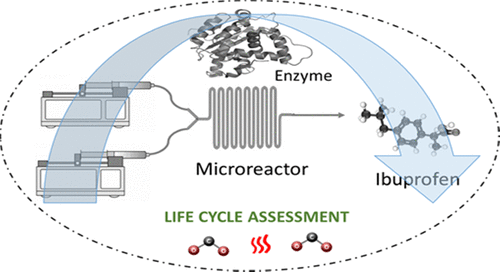当前位置:
X-MOL 学术
›
ACS Sustain. Chem. Eng.
›
论文详情
Our official English website, www.x-mol.net, welcomes your
feedback! (Note: you will need to create a separate account there.)
Life Cycle Assessment of an Enzymatic Ibuprofen Production Process with Automatic Recycling and Purification
ACS Sustainable Chemistry & Engineering ( IF 7.1 ) Pub Date : 2021-09-17 , DOI: 10.1021/acssuschemeng.1c02309 Fabio Grimaldi 1 , Nam Nghiep Tran 2, 3 , M. M. Sarafraz 2, 4 , Paola Lettieri 1 , Olivia Maria Morales-Gonzalez 5 , Volker Hessel 2, 6
ACS Sustainable Chemistry & Engineering ( IF 7.1 ) Pub Date : 2021-09-17 , DOI: 10.1021/acssuschemeng.1c02309 Fabio Grimaldi 1 , Nam Nghiep Tran 2, 3 , M. M. Sarafraz 2, 4 , Paola Lettieri 1 , Olivia Maria Morales-Gonzalez 5 , Volker Hessel 2, 6
Affiliation

|
In this study, the environmental impacts of three ibuprofen production routes, namely, the BHC, the Bogdan, and the newly developed enzymatic synthetic routes (modified Bogdan process), are assessed and compared by the application of life cycle assessment (LCA). Based on the data obtained through literature and laboratory-based experiments, a pilot-scale production with a capacity of 500 g/day of ibuprofen was simulated to generate inventory data for the LCA study, using Aspen Plus V11. The well-established BHC process was chosen as the benchmark to quantify the operational and environmental benefits of the innovative enzymatic Bogdan flow synthetic process. The comparison highlights the benefit of adopting the modified Bogdan synthesis route via an enzymatic catalyst. Results show that a general reduction of environmental impact is achievable across the whole set of impact categories of the analysis, and the magnitude of such reduction depends on the efficiency of recycling in the production system. Considering a 50% efficiency of recycling, the modified Bogdan system achieves lower environmental impacts in some impact categories like Acidification, Ecotoxicity of freshwater, Human toxicity, Particulate matter, and Resource depletion (mineral, fossils, renewables) while having higher impacts on the rest of the impact categories. Yet, the new process proposed here scores better environmental performances in all of the impact categories when the enzyme recycling is close to 100%, which is promising for future technology development.
中文翻译:

具有自动回收和纯化功能的酶促布洛芬生产过程的生命周期评估
在本研究中,应用生命周期评估(LCA)评估和比较了三种布洛芬生产路线,即 BHC、Bogdan 和新开发的酶法合成路线(改进的 Bogdan 工艺)对环境的影响。基于通过文献和实验室实验获得的数据,模拟了布洛芬 500 克/天产能的中试规模生产,以使用 Aspen Plus V11 生成 LCA 研究的库存数据。成熟的 BHC 工艺被选为基准,以量化创新的酶促 Bogdan flow 合成工艺的操作和环境效益。比较突出了通过酶催化剂采用改进的 Bogdan 合成路线的好处。结果表明,在分析的整个影响类别中,环境影响的总体减少是可以实现的,这种减少的幅度取决于生产系统中的回收效率。考虑到 50% 的回收效率,改进后的 Bogdan 系统在某些影响类别中实现了较低的环境影响,例如酸化、淡水的生态毒性、人类毒性、颗粒物和资源枯竭(矿物、化石、可再生能源),同时对其他方面的影响更大的影响类别。然而,当酶回收率接近 100% 时,这里提出的新工艺在所有影响类别中都获得了更好的环境性能,这对未来的技术发展很有希望。这种减少的幅度取决于生产系统中的回收效率。考虑到 50% 的回收效率,改进后的 Bogdan 系统在某些影响类别中实现了较低的环境影响,例如酸化、淡水的生态毒性、人类毒性、颗粒物和资源枯竭(矿物、化石、可再生能源),同时对其他方面的影响更大的影响类别。然而,当酶回收率接近 100% 时,这里提出的新工艺在所有影响类别中都获得了更好的环境性能,这对未来的技术发展很有希望。这种减少的幅度取决于生产系统中的回收效率。考虑到 50% 的回收效率,改进后的 Bogdan 系统在某些影响类别中实现了较低的环境影响,例如酸化、淡水的生态毒性、人类毒性、颗粒物和资源枯竭(矿物、化石、可再生能源),同时对其他方面的影响更大的影响类别。然而,当酶回收率接近 100% 时,这里提出的新工艺在所有影响类别中都获得了更好的环境性能,这对未来的技术发展很有希望。改进后的 Bogdan 系统在某些影响类别中实现了较低的环境影响,例如酸化、淡水生态毒性、人类毒性、颗粒物和资源消耗(矿物、化石、可再生能源),同时对其他影响类别的影响更大。然而,当酶回收率接近 100% 时,这里提出的新工艺在所有影响类别中都获得了更好的环境性能,这对未来的技术发展很有希望。改进后的 Bogdan 系统在某些影响类别中实现了较低的环境影响,例如酸化、淡水生态毒性、人类毒性、颗粒物和资源消耗(矿物、化石、可再生能源),同时对其他影响类别的影响更大。然而,当酶回收率接近 100% 时,这里提出的新工艺在所有影响类别中都获得了更好的环境性能,这对未来的技术发展很有希望。
更新日期:2021-10-04
中文翻译:

具有自动回收和纯化功能的酶促布洛芬生产过程的生命周期评估
在本研究中,应用生命周期评估(LCA)评估和比较了三种布洛芬生产路线,即 BHC、Bogdan 和新开发的酶法合成路线(改进的 Bogdan 工艺)对环境的影响。基于通过文献和实验室实验获得的数据,模拟了布洛芬 500 克/天产能的中试规模生产,以使用 Aspen Plus V11 生成 LCA 研究的库存数据。成熟的 BHC 工艺被选为基准,以量化创新的酶促 Bogdan flow 合成工艺的操作和环境效益。比较突出了通过酶催化剂采用改进的 Bogdan 合成路线的好处。结果表明,在分析的整个影响类别中,环境影响的总体减少是可以实现的,这种减少的幅度取决于生产系统中的回收效率。考虑到 50% 的回收效率,改进后的 Bogdan 系统在某些影响类别中实现了较低的环境影响,例如酸化、淡水的生态毒性、人类毒性、颗粒物和资源枯竭(矿物、化石、可再生能源),同时对其他方面的影响更大的影响类别。然而,当酶回收率接近 100% 时,这里提出的新工艺在所有影响类别中都获得了更好的环境性能,这对未来的技术发展很有希望。这种减少的幅度取决于生产系统中的回收效率。考虑到 50% 的回收效率,改进后的 Bogdan 系统在某些影响类别中实现了较低的环境影响,例如酸化、淡水的生态毒性、人类毒性、颗粒物和资源枯竭(矿物、化石、可再生能源),同时对其他方面的影响更大的影响类别。然而,当酶回收率接近 100% 时,这里提出的新工艺在所有影响类别中都获得了更好的环境性能,这对未来的技术发展很有希望。这种减少的幅度取决于生产系统中的回收效率。考虑到 50% 的回收效率,改进后的 Bogdan 系统在某些影响类别中实现了较低的环境影响,例如酸化、淡水的生态毒性、人类毒性、颗粒物和资源枯竭(矿物、化石、可再生能源),同时对其他方面的影响更大的影响类别。然而,当酶回收率接近 100% 时,这里提出的新工艺在所有影响类别中都获得了更好的环境性能,这对未来的技术发展很有希望。改进后的 Bogdan 系统在某些影响类别中实现了较低的环境影响,例如酸化、淡水生态毒性、人类毒性、颗粒物和资源消耗(矿物、化石、可再生能源),同时对其他影响类别的影响更大。然而,当酶回收率接近 100% 时,这里提出的新工艺在所有影响类别中都获得了更好的环境性能,这对未来的技术发展很有希望。改进后的 Bogdan 系统在某些影响类别中实现了较低的环境影响,例如酸化、淡水生态毒性、人类毒性、颗粒物和资源消耗(矿物、化石、可再生能源),同时对其他影响类别的影响更大。然而,当酶回收率接近 100% 时,这里提出的新工艺在所有影响类别中都获得了更好的环境性能,这对未来的技术发展很有希望。











































 京公网安备 11010802027423号
京公网安备 11010802027423号